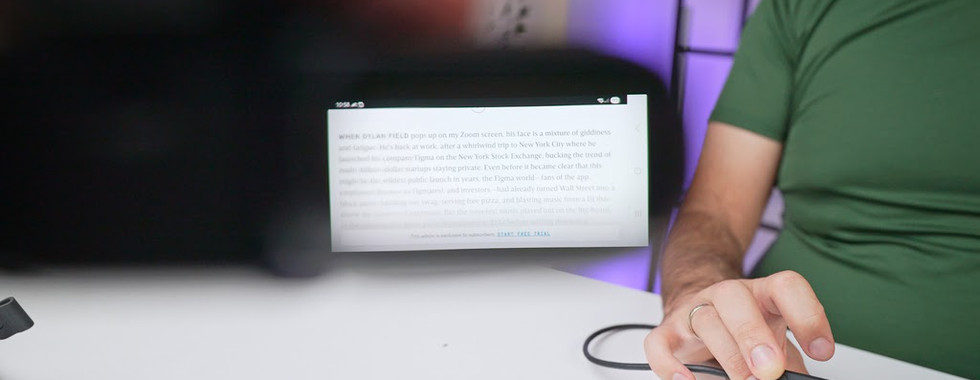Why This Tiny Screen Might Replace Your Devices - Goovis ART
- A2K
- Aug 21
- 6 min read
What if your next screen wasn’t on a wall or a desk but right in front of your eyes? Not VR. Not projector. A real, high-res display you can wear, plug into almost anything, and take anywhere.
That’s exactly what the GOOVIS Art head mounted display offers. And after testing it across a bunch of real-world scenarios, like movies, mobile gaming, productivity, even PC as a second screen, here is our verdict upfront.
The screen quality is excellent! Sharp, vibrant, and surprisingly immersive.
Usability? Better than I expected. But there are caveats. Since the screen moves with your head, reading small text or playing detail-heavy games takes a bit of getting used to.
The real strength here is flexibility. It’s not trying to replace your TV, it’s simple, versatile add-on for people who want a personal screen anywhere.
And since it’s just a screen with no internal OS, no battery to degrade, it won’t age the same way as other gadgets. It’s something you can keep using creatively over time.
It’s not essential. But it is genuinely fun, well-built, and way more useful than I initially thought. You just need to find your use case, and I’m willing to bet there are plenty more we haven’t even considered yet.
Now let’s walk through what’s in the box, how it works, and all the pros and quirks I found along the way.
Inside the main box, you’ll find the GOOVIS unit, a USB-C to USB-C cable, a cleaning cloth, and a quick start guide. The HDMI adapter is straightforward and doesn’t need much explanation. As for the Android TV dongle, it includes a sleek magnetic power bank (which is not needed if you’re powering it via cable) and a remote control, though, as usual, you’ll need to supply your own batteries.
We also received their Zero Pressure Headband, which turned out to be one of the best upgrades. It is not a part of the standard kit, but I’ll talk about it more in a bit.
The headset is compact and feels light enough to wear comfortably, especially given how much tech is packed inside. Setup is just as straightforward — plug it into a phone that supports USB-C and it instantly turns into your screen.
Adjustment-wise, it has independent per-eye myopia dials with satisfying clicky steps, and a lockable IPD slider. It’s great to see support for glasses too, you can either leave them on or fine-tune the optics to match your vision.
But a few things could improve. I was disappointed to see that there is no built-in test pattern to help you dial it in. I would also love a lock for diopter adjustments or even some presets. These are not dealbreakers or anything, just things I would love to see added.
Comfort-wise, the unit feels well-balanced thanks to its lightweight design. Since it doesn’t rest directly on your nose, it stays comfortable even during longer sessions. I did find myself wishing it could sit a little closer to the eyes to make the screen feel larger. The only workaround was to tilt it down slightly, but that puts some strain on your neck over time.
Then we tested the Zero Pressure Headband and surprisingly it makes a huge difference. It secures with a twist knob at the back, centres automatically, and spreads the weight more evenly across your head. The original strap isn’t bad, but once you try the Zero Pressure one, it feels like this should be the standard.
The strap comes with two padding options: anti-slip silicone and leather. Both work well, even in hot and sweaty Singapore, though I slightly prefer the leather for long sessions. You can remove and wash the face pad. I don’t recommend machine washing it, but it’s nice to have that option for hygiene.
And before we talk about visuals, let me warn you about one important thing that should not have been left for the very last page of the manual - don’t plug any power into the headset’s USB ports, this could easily damage the unit. Ok – visuals! This screen is shockingly sharp. There are no visible pixels, and colours look fantastic. It’s plenty bright for indoor use and doesn’t blast your face with heat either.
That said, there’s a learning curve. If the screens aren’t perfectly aligned with your eyes, the image can skew, or parts may look off. I wish there was an indicator to tell if it’s “straight” on your head, at the moment you just sort of feel it out. But once you zone in, especially when watching video, you get used to the situation and it just feels like a screen floating in space.
Audio-wise, the built-in speakers are fine. If you care about sound quality, use Bluetooth or try plugging headphones in. Though I should mention, I couldn’t get USB-C audio to work, but the 3.5mm audio on the side works well.
I also tried this out for gaming. On PC, I tried Civilization VI by using the HDMI dongle. It was easy to set up as a second screen, and while it’s only 1080p, the clarity is solid. Diopter adjustments again helped sharpen the text. I would say closing one eye and fine-tuning works best here.
However, games that involve a lot of reading can be a challenge. Since the display moves with your head, you have to hold incredibly still, almost like a sniper, just to read through blocks of text without everything shifting. It’s not impossible, but definitely not ideal for strategy games or dialogue-heavy RPGs. Visibility at the edges is also more limited. It feels a bit like looking into a box where the centre is clear, but you have to shift your head to catch what’s in the corners. To be clear, this isn’t a fault of the screen quality, it’s more about the field of view and how the image follows your movement.
Now let’s focus on mobile gaming, which is where the GOOVIS really shines. I tested Asphalt 9 with an Xbox controller, and the experience was brilliant. It felt like having a full console strapped to my face, it was smooth, immersive, and fun. For me, this is the ideal use case: gaming while travelling or relaxing on the couch with something like a Steam Deck or ROG Ally. Just stick to action games, not text-heavy ones.
The included Android dongle is surprisingly capable. It draws power via HDMI, no extra cables needed, and sets up quickly via your phone. It comes pre-installed with Prime, Disney+, and YouTube. Once set up, this feels like a personal cinema. The sound was actually louder here than when connected to my phone, and Google Assistant support is built in, though voice commands might feel odd if you’re on the move.
There are many other use cases for this too! I also tried using the GOOVIS during video calls while writing on my laptop. It’s entirely possible to have a video playing on the headset while working on your main screen. You’ll definitely look like a cyborg doing it, so maybe not something for the coffee shop just yet… but honestly, we’re not that far off.
Now one of the most unexpectedly useful scenarios I tested was using it as a monitor for my video camera.
Here’s the setup: camera HDMI out → into the HDMI dongle → and then into the GOOVIS. The dongle does need power, but a small power bank solves that. What you end up with is a massive, crisp screen right in front of your eyes — perfect for framing, monitoring focus, and adjusting settings — while still being able to see your surroundings. You’re not blocked off like in a VR headset, so you’re not going to trip over a light stand.
This is so much easier than rigging up a chunky field monitor, dealing with mounting arms and cables, especially if you’re moving around. The same concept could easily apply to drone work as well, giving you a large, immersive screen while still allowing you to stay aware of your surroundings. Honestly, this use case alone might sell it to creators or field operators who need a portable, immersive, and clear monitor solution.
And again, because the GOOVIS Art is just a display with no internal OS or battery, this isn’t a device that’s going to “age out” of relevance. If you find a solid niche for it, chances are it’ll stay useful for years to come.
The image quality is fantastic, comfort is decent with a clear upgrade path via the zero-pressure strap, and the number of things you can do with it is surprisingly broad — from watching movies in bed to gaming on a flight or even using it as a portable camera monitor.
It’s not trying to replace your TV or your VR headset. Instead it squeezes into a unique space, giving you a high-quality screen, wherever you want it, without being completely cut off from the world.
It has its quirks, particularly with text readability and optical adjustments, but overall it performed better than I initially thought. I went in curious and came out genuinely impressed.
If you’re a frequent traveller, a content creator, or just someone who wants a personal cinema experience without taking over the living room, this might just be worth a closer look.
Let us know in the comments what your use case would be. Would you take it on a plane? Use it for gaming on the go? Or maybe have it as your new field monitor setup?































































Comments